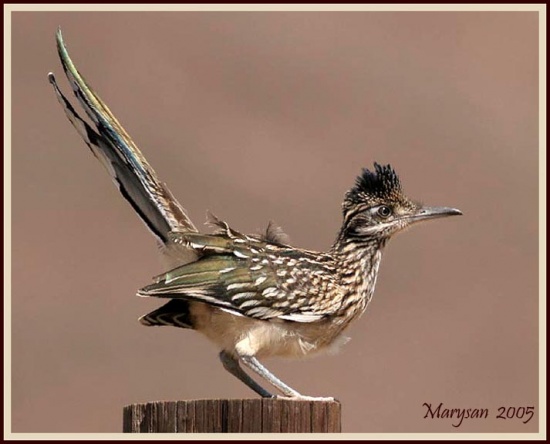(Add flight and juvenile photos) |
|||
| Line 1: | Line 1: | ||
;[[: Category:Geococcyx|Geococcyx]] californianus | ;[[: Category:Geococcyx|Geococcyx]] californianus | ||
| − | [[Image:Greater_Roadrunner.jpg|thumb|550px|right|Photo by Marysan<br> | + | [[Image:Greater_Roadrunner.jpg|thumb|550px|right|Photo by {{user|Marysan|Marysan}}<br>Pamo Valley, [[California]], July 2005]] |
| − | |||
==Identification== | ==Identification== | ||
| Line 16: | Line 15: | ||
*Sometimes has a patch of bare skin behind the eyes with colors of blue, red and orange | *Sometimes has a patch of bare skin behind the eyes with colors of blue, red and orange | ||
| + | [[Image:Gtr Roadrunner flying.jpg|thumb|350px|right|Photo by {{user|4Niles|4Niles}}<br>Scottsdale, [[Arizona]], July 2012]] | ||
==Distribution== | ==Distribution== | ||
[[Mexico]], southwest and southern midwest states of [[USA]], in suitable terrain. | [[Mexico]], southwest and southern midwest states of [[USA]], in suitable terrain. | ||
| Line 22: | Line 22: | ||
Some authorities sees this as a monotypic species others recognize four subspecies: ''californianus'', ''kongligi'', ''conklingi'', and ''dromicus''. | Some authorities sees this as a monotypic species others recognize four subspecies: ''californianus'', ''kongligi'', ''conklingi'', and ''dromicus''. | ||
| + | [[Image:Gtr Roadrunner fledgling.jpg|thumb|350px|right|Fledgling<br>Photo by {{user|4Niles|4Niles}}<br>Scottsdale, [[Arizona]], April 2012]] | ||
==Habitat== | ==Habitat== | ||
Dry, hot country. Scrub, chapparal, agricultural areas, urban fringes. | Dry, hot country. Scrub, chapparal, agricultural areas, urban fringes. | ||
==Behaviour== | ==Behaviour== | ||
| − | Spends most of its time on the ground, often solitary. Flies with reluctance | + | Spends most of its time on the ground, often solitary. Flies with reluctance, especially if threatened, when it will fly into brush cover to hide. Flying is more of an open, extended-wing gliding, from the nest or other high perch.<br/> |
Can be quite tame where not persecuted. | Can be quite tame where not persecuted. | ||
| Line 40: | Line 41: | ||
==External Links:== | ==External Links:== | ||
{{GSearch|Geococcyx+californianus}} | {{GSearch|Geococcyx+californianus}} | ||
| + | |||
[[Category:Birds]][[Category:Geococcyx]] | [[Category:Birds]][[Category:Geococcyx]] | ||
Revision as of 21:07, 1 June 2013
- Geococcyx californianus
Identification
L. 51-61 cm
Ws. 81 cm
Usually seen walking or running along desert terrain, weaving skillfully through openings in fences or underbrush.
- Upper parts, chin, and chest are heavily streaked brown and white;
- Buff belly
- Shaggy crest on head, not always erect
- Heavy black bill with hooked tip
- Slightly downturned
- Long pale blue legs and feet
- Sometimes has a patch of bare skin behind the eyes with colors of blue, red and orange
Distribution
Mexico, southwest and southern midwest states of USA, in suitable terrain.
Taxonomy
Some authorities sees this as a monotypic species others recognize four subspecies: californianus, kongligi, conklingi, and dromicus.
Habitat
Dry, hot country. Scrub, chapparal, agricultural areas, urban fringes.
Behaviour
Spends most of its time on the ground, often solitary. Flies with reluctance, especially if threatened, when it will fly into brush cover to hide. Flying is more of an open, extended-wing gliding, from the nest or other high perch.
Can be quite tame where not persecuted.
This fairly common member of the cuckoo family (Cuculidae) was called the Ground Cuckoo in centuries past, because it was often seen running along in front of carriages. They can still be commonly seen darting across or along roads, although at a peak speed of 15mph, they can no longer keep up with traffic.
Diet
Runs to catch snakes, lizards, small birds and rodents. One of the only animals known to attack rattlesnakes.
Breeding
Monogamous breeder.






